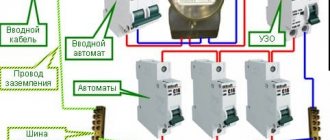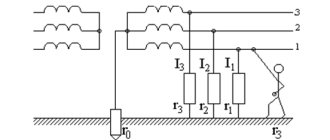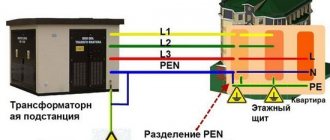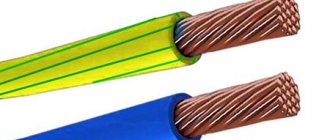Back in Soviet times, a package switch was installed in all apartments and on staircase landings. It served as a switch to completely turn off/on electricity.
But since its power is low, it was replaced by modern automatic machines, especially since the package switch device does not automatically disconnect from the network in the event of a short circuit or overload. And due to voltage surges, it quickly fails.
However, due to the low cost, compactness and large switching life of the device, it is still in use. Now it is still used in switchboards, power circuits, cranes, control panels, excavators, driver's cabins of electric power units, in substations (by special personnel) to take readings.
What is a packet switch
The switch has a manual operating principle and switches alternating current in power lines with a voltage of 660 volts and direct current in power lines with a voltage of 440 volts. They are installed in main panels, as well as in electrical cabinets on input switches.
The body of the device is made of dielectric material. The switch has arc extinguishing chambers, as well as grooves for electrical connections. In the central part of the bag there is a movable washer on which the knives and electrodes are located. All these moving parts are strung on one axis, through which the device is launched.
By turning the handle of the device, the moving washers begin to move. These movements are transmitted to the contacts, causing connections to close or open.
Packers are manufactured in 10A and 25A for an electrical circuit with a voltage of 220 volts, which have one, two and three poles. For power lines with a voltage of 380 volts, 6A and 15A switches are available. With the specified current indicators and a power factor of 8, the devices are capable of switching 20 thousand times, while there should be no more than 300 switchings per hour. Switches are classified according to the degree of protection and are divided into open, protective and sealed.
The protective type of bags has a plastic case that protects against touching and contacts of foreign objects.
Sealed devices have an aluminum or plastic shell that prevents water from penetrating into the interior of the device.
Design features of the bag
The package design includes a contact group and a switching mechanism. They are enclosed in a shell, which also contains movable contacts fixed on a square sleeve made of electrical insulating material.
The device is equipped with fixed contacts, the terminals of which extend from the housing and are shaped like knives. The contacts are connected and disconnected using a spring. It is controlled by a switch.
Turning the handle winds the spring of the switching mechanism. It turns the figured washer and movable contacts a quarter turn. The stroke of the washer is limited by a stop located in the cover.
The moving contacts are attached to plates made of fiber. When the material heats up, it releases gas, which moves under pressure through the openings of the bag. Instead of gas, non-ionized air enters the housing and extinguishes the arc.
Due to their simplicity of design and ease of use, bags are widely used in the following areas:
- as input switches;
- for switching control circuits;
- as electric current distributors;
- for controlling electric motors.
Deciding on the denomination
Actually, from the functions of the circuit breaker, the rule for determining the rating of the circuit breaker follows: it must operate until the current exceeds the capabilities of the wiring. This means that the current rating of the machine must be less than the maximum current that the wiring can withstand.
For each line you need to choose the right circuit breaker
Based on this, the algorithm for selecting a circuit breaker is simple:
- Calculate the wiring cross-section for a specific area.
- See what maximum current this cable can withstand (see the table).
- Next, from all the ratings of the circuit breakers, we select the nearest smaller one. The ratings of the machines are tied to the permissible long-term load currents for a particular cable - they have a slightly lower rating (see the table). The list of denominations looks like this: 16 A, 25 A, 32 A, 40 A, 63 A. From this list you choose the appropriate one. There are smaller values, but they are practically not used anymore - we have too many electrical appliances and they have considerable power.
The algorithm is very simple, but it works flawlessly. To make it clearer, let's look at an example. Below is a table that shows the maximum permissible current for conductors that are used when laying wiring in a house and apartment. Recommendations regarding the use of machines are also given there. They are given in the column “Nominal current of the circuit breaker”. This is where we look for the ratings - it is slightly less than the maximum permissible for the wiring to work normally.
Cross section of copper wires
Permissible continuous load current
Maximum load power for single-phase network 220 V
Rated current of circuit breaker
In the table we find the selected wire cross-section for this line. Suppose we need to lay a cable with a cross-section of 2.5 mm 2 (the most common when laying to medium-power devices). A conductor with this cross-section can withstand a current of 27 A, and the recommended rating of the machine is 16 A.
How will the circuit work then? As long as the current does not exceed 25 A, the machine does not turn off, everything works as normal - the conductor heats up, but not to critical values. When the load current begins to increase and exceeds 25 A, the machine does not turn off for some time - perhaps these are starting currents and they are short-lived. It turns off if the current exceeds 25 A by 13% for a sufficiently long time. In this case, if it reaches 28.25 A. Then the power supply will work and de-energize the branch, since this current already poses a threat to the conductor and its insulation.
Power calculation
Is it possible to choose a machine based on load power? If only one device is connected to the power line (usually large household appliances with high power consumption), then it is permissible to make a calculation based on the power of this equipment. You can also choose an introductory machine based on power, which is installed at the entrance to a house or apartment.
If we are looking for the rating of the input circuit breaker, we need to add up the power of all devices that will be connected to the home network. Then the found total power is substituted into the formula, and the operating current for this load is found.
Formula for calculating current from total power
After we have found the current, select the nominal value. It may be either slightly more or slightly less than the found value. The main thing is that its shutdown current does not exceed the maximum permissible current for this wiring.
When can you use this method? If the wiring is laid with a large margin (this is not bad, by the way). Then, in order to save money, you can automatically install switches corresponding to the load, and not the cross-section of the conductors
But once again we draw your attention to the fact that the long-term permissible current for the load must be greater than the maximum current of the circuit breaker. Only then will the choice of circuit breaker be correct
Useful tips
Sometimes connecting a circuit breaker is associated with the correct implementation of some nuances of the entire process. Namely, by connecting wires to the device
What do you need to pay attention to?
Each model has its own requirements regarding the cross-section of the inserted wire and the length of the insulating sheath
This must be indicated in the product passport. Most often, the wire needs to be stripped to a length of 0.8 to 1.0 cm. It is important to understand that placing a wire with insulation in a clamp is unacceptable, because the diameter of the insulation is larger than the diameter of the core itself, so the contact between the clamp and the core will either be weak or completely absent. The wire is fixed in the machine with a screw, which is tightened with a screwdriver. After fixing, you need to check the quality of the clamp; to do this, the wire itself must be tugged slightly. If a stranded conductor is used to connect the machine, then it is best to put a tip on its end.
What types of circuit breakers are there?
To protect conductors of a single-phase 220 V network, there are single-pole and double-pole disconnecting devices. To single-pole wires, only one conductor is connected - phase, to double-pole wires, both phase and neutral. Single-pole circuit breakers are installed on indoor lighting circuits and on socket groups in rooms with normal operating conditions.
In rooms with high humidity (bathroom, bathhouse, swimming pool, etc.) two-pole circuit breakers are installed. They are also recommended for installation on powerful appliances - washing machines, dishwashers, boilers, ovens, etc.
It’s just that in emergency situations - in the event of a short circuit or insulation breakdown - phase voltage can reach the neutral wire. If a single-pole device is installed on the power line, it will disconnect the phase wire, and the zero with dangerous voltage will remain connected. This means there is still a possibility of electric shock when touched. That is, the choice of machine is simple - single-pole switches are installed on some lines, and double-pole switches on others. The specific amount depends on the network condition.
Automatic machines for single-phase networks
For a three-phase network, there are three-pole circuit breakers. Such a machine is installed at the entrance and at consumers, to which all three phases are supplied - an electric stove, a three-phase hob, an oven, etc. The remaining consumers are equipped with two-pole circuit breakers. They must disconnect both phase and neutral.
Example of three-phase network wiring - types of circuit breakers
The choice of circuit breaker rating does not depend on the number of wires connected to it.
Why change?
If the question is whether it is worth changing to AB, even if the switch is working, then the answer is unequivocal - yes. This is not only recommended and desirable, but also, one might say, mandatory for the following reasons:
- protection can only be provided by AB;
- connect another automatic protective shutdown device (RCD, RCBO), which is mandatory, for example, in the absence of grounding, when using boilers (powerful electrical appliances) in the house, and, however, it is always, of course, more expedient and convenient with AV;
- if there is a DIN rail, then the modular placement of AB, RCD, RCBO is extremely convenient, although there are shields with it bolted to the box body.
Performance
Its service life largely depends on how quickly the switch turns on and closes its contacts. However, is it possible to determine at home how well your device corresponds to this parameter without disassembling the case itself and without resorting to specialized laboratory tests?
Of course you can. Everything is done very simply. Take a regular battery-powered indicator screwdriver. Exactly with the battery.
It is usually used for testing and determining the integrity of the circuit. Although knowledgeable people use this useful device in many other ways. Read about which ones in a separate article.
Use the tip of a screwdriver to touch the upper contact, pressing the metal patch on the handle from above, and with the finger of your other hand, touch the lower contact of the switch.
After which, you slowly begin to turn on the machine, cocking the tongue.
The contact should appear (the LED in the screwdriver will light up) only at the very last moment, when the device has already clicked.
If the same manipulation is done with another switch, the light comes on when the power lever reaches the middle of the stroke.
It turns out that the device is not yet cocked, but the contacts are already closed. This is what this sometimes leads to under heavy load (view of the contacts from inside the machine):
This ultimately affects the rapid wear and burnout of contacts. While the quick-start mechanism increases the service life of the product by almost 30%.
Marking
The average person pays attention only to the brand name and amperage, which the manufacturer applies to the body using laser technology or indelible paint. All indicators are important for professionals
Depending on the machine, the number of characteristics may vary.
Marking
This is what is hidden under the numbers and letters on the front side:
- ABB, IEK, Legrand - manufacturer's logo.
- S, SH, Acti, Easy, BM, TX - linear series of modular products. The letter may be followed by various numbers.
- 6, 10, 16 and more - the maximum current value at which the circuit does not open. It is worth noting that the indicator is relevant at a temperature of +30 degrees Celsius. The product is triggered by an overload of 13-55%. If it is colder, the machine will turn off at a higher load, and vice versa in the heat.
- 230V, 400V - network voltage (single-phase or three-phase) at which use is allowed.
- 4500, 6000 or 10000 is the limit (switching capacity) at which tripping occurs during a short circuit. In this case, the device does not fail. If a short circuit occurs with a value exceeding the value, the magnetic release will not cope with it and the device will burn out. The indicator is enclosed in a rectangle.
Short circuit limits
- 1, 2 or 3 next to the short circuit - an indicator of the speed of extinguishing the electric arc (from 10 ms, from 6 ms and from 2.5 ms, respectively). During a short circuit, the conductors heat up, which affects the insulation. The faster the machine works, the more intact the wiring and the device itself will be. The first class is usually not indicated.
- B, C, D, K, Z before amperage - time for automatic shutdown of the device in the event of a short circuit or overload in the network. In everyday life, products with characteristics of type C are more often used, less often B and D. For example, C16 will turn off at 80-160A, and B16 at 46-80A. That is, the second one will work later. The difference is in fractions of a second.
- Wave or straight line - can be used in AC or DC voltage networks. These marks are located next to the rated voltage.
Voltage
- 50/60 Hz - frequency of oscillations in the network. The indicator is not always indicated, since most household appliances operate in one mode.
- Connection diagram. 1, 3, 5 and 2, 4, 6 - upper (supply) and lower (loaded) contacts. N - pole for connecting the neutral core.
On the side plane it is indicated:
- GOST or IEC/EN - compliance with standards (Russian or international).
- U is the operating voltage.
- Icn is the maximum breaking capacity value.
- I—electromagnetic shutdown limit.
- Uimp is the impulse withholding voltage.
- Ui is the insulation voltage.
- Deg is the degree of pollution, which depends on moisture condensation.
- Cat - application category regarding selectivity.
- Barcode or QR code is information about a product that, when read by a special device, is obtained on the trading platform.
Barcode
In addition, the manufacturer indicates the tightening torque, the number of poles, and the type of release. Differential machines have additional markings.
Three-phase and two-position switches of modular type
Batch switch device
Devices of this class are installed in three-phase networks and allow switching the power supply to powerful asynchronous electric motors. In particular, they are used to switch a set of 3 windings from one switching circuit to another: from delta to star and back.
Switching the connection modes of the stator windings is necessary to reduce the magnitude of inrush currents in the power circuits - to “facilitate” starting.
Two-position modular switches are represented in the range of electrical products by cam-type batch switches. They are widely in demand in the following situations:
- when installing control panels for AC and DC power equipment;
- in modern power grids equipped with automatic backup systems;
- for switching winding circuits and operating modes of electric motors, as well as for controlling lighting from several points at once;
- to select suitable operating conditions for transformer substations (TS), as well as to optimize the operation of the switching equipment serving them;
- when choosing the desired mode for heating equipment and welding units.
Three position packet switch
One of the varieties of two-position switches are devices that, in addition to two extreme positions, also have one central one. Formally, they are classified as three-position switches with one neutral position, but in circuits they are still used as two-terminal devices.
To make it easier to select the required sample of a switching product suitable for specific conditions, the main technical parameters are indicated on the housing:
- type of switching device;
- rated current for which its operating contacts are designed;
- electrical switching diagram (switching table);
- category of protection from climatic influences.
What is the difference, advantages and disadvantages
The first thing that needs to be said about the packetizer is that it is a manual device, without automatic operation (snapping off with release of contacts during overloads, short circuit). For on/off chain, you must manually turn its handle with a tight stroke.
It must be said that the design still remains functional, but for housing it has largely lost its relevance. On the other hand, in electrical installations (industry, manufacturing, energy, stations), where the specificity requires the manual principle of activation/deactivation of equipment, the use of packets is widespread and is a standard. In new housing such switches have not been installed for a long time; instead of them - AB. As a rule, replacement is always done if electrical communications are repaired, wiring or panels are updated.
Differences between a packager and a circuit breaker (AB)
Packers are being replaced with automatic switches. As a rule, there is no alternative to automatic machines. ABs are much more modern with autonomous response to overloads, and they can also be controlled manually: move the switch, closing/opening the circuit when needed, that is, the device is much more versatile.
| Characteristic | Switches | |
| Batch | Auto | |
| Functions | Switching only. | Switching and protection against overloads and short-circuit currents. |
| Design | Fully mechanical circuit contact opening/closing design requiring only manual operation. Simply put, the principle of operation of the product is the same as that of ordinary household lighting switches. | It contains two releases:
|
| Control | All control is manual only. | Activation is only manual, and this is logical, since the user must be able to activate the source of danger—the network—himself. Shutdown - both manual and automatic. |
| Installation | To the shield body or to the rail, but usually only with screws. | The DIN bar has a snap-on design, and there are also accessories for screw and other fixations. |
| Possibility of other switching schemes (options) | Yes, variations between terminals are possible. | No, but this is not required in the terms of use. |
Features of differences
The main difference is that the machine has the function of protecting the circuit from short circuits and overloads, and turns itself off in case of danger, while the packet switch is an ordinary mechanical switch, its principle is no different from that. Hand switches are usually round, multifaceted, with a longitudinal handle, and often have a retro design. AB is a flat gray plastic box with yellow, red, blue, etc. colors, small levers (flags) with up/down movement. Older models may be push-button. Such boxes are conveniently placed modularly - they can be simply and easily added in a row on a DIN rail.
With a package switch, if, for example, no one is at home and there is no one to turn the switch, the overload will remain in effect until the wiring completely burns out, and this can cause a fire in the entire building. And with AB there will be automatic release of contacts, disconnection, de-energization at the slightest sign of incorrect operation of the network. The maximum that can happen is that the wiring will overheat a little.
The circuit breaker protects the wiring from heating and melting, fire; the following stages of protection in the form of an automatic shutdown are selected for it and the cross-section of the conductors - RCD, RCBO. The latter and AB can also be installed on the package.
Advantages and disadvantages
The advantages of AV are obvious - automaticity, compactness, ease of installation, circuit protection. Disadvantages of the package: none of the above, and also the switches break due to frequent power surges, the contacts can burn out. AB does not have such a property, since it will simply open the circuit, which will prevent heating of the device.
AV has no disadvantages compared to packagers, except for one exception, but it is due to the specificity of the use environment. In electrical installations, at electricity production and distribution facilities (stations, substations), sometimes a manual switch off/on method is required. and the ability to change contact options - then a manual switch is indispensable.
Updated analogues of the device
Automatic bagger GB2-CB12 6A
Outdated models of baggers installed in electrical panels are everywhere being replaced by more convenient and reliable machines. This is due to the fact that the requirements for the operating efficiency of such devices have changed. They must combine the capabilities of RCDs, simple and differential circuit breakers, and sometimes contactors when installed in 380 Volt power circuits. Before connecting the protective device, you will need to familiarize yourself with the features of each of the designated functions.
RCD and automatic
When operating in RCD mode, the device guarantees human protection from high voltage damage. It reacts to the difference current that occurs when leaks appear in emergency circuits, which can lead to a short circuit, as well as fire of electrical wiring. In a dangerous situation, the device simply turns off the electrical network and prevents further development of undesirable events. To monitor its performance, there is a special button on the case labeled “Test”.
Difavtomat
A difavtomat is a universal device that combines the functions of an RCD and a conventional AV. It completely replaces package switches installed not only in household electrical networks, but also in enterprises. In other words, a difavtomat is “2 devices in one”, combined in a common housing. This device copes well with both functions, being small in size and easy to handle.
Contactor (powerful e/m relay)
Contactor e/m KT 6033B 250A 220V
Devices such as contactors are used when it is necessary to switch electrical circuits with currents up to hundreds of Amperes. A special feature of these devices is the ability to control switching modes at remote distances. Electromagnetic relays do not respond to leakage currents, since they are designed only for their nominal values. This makes them significantly different from conventional circuit breakers. Such devices are traditionally installed in elevator mechanisms, electric vehicles, and industrial equipment.
In modern conditions, it makes no sense to install outdated models of package switches in place of input circuit breakers. For these purposes, reliable and easy-to-use automatic devices with increased functionality are better suited. However, this brand of switching devices is indispensable in other places where it is necessary to manually remove the power supply during installation operations, for example.
Cable cross-section for machine s16
In residential buildings, as a rule, a single-phase network is used. Therefore, wiring is chosen with 2 or 3 cores. Their cross-sectional diameter must correspond to the installed 16-amp electric machine. The maximum permissible diameter is 25 square meters. mm, but the indicator also depends on the metal of which the cable is composed. Here is their comparative characteristics:
Metal in wires
| Criterion | Aluminum wire | Copper wire |
| Cross section | From 2.5 sq. mm | From 0.35 sq. mm |
| Current conductivity | Up to 3 kW at minimum cross-section | The figure is approximately 1.6 times higher |
| Life time | 15-20 years | About 50 years |
| Strength | The wire breaks easily when bent | Due to the plasticity of the metal, the wiring can be laid at any angle. The fragility index for the same cross-section is 2-3 times lower. |
| Ease of installation | To power a modern outlet, you need a wire with a cross-section of 4 square meters. mm. The built-in terminals have a tolerance of 3 mm. That is, a connection with a nominal value of 16A is excluded. | For a similar task (16A socket), a cable with a core cross-section of 1.5-2.5 square meters is required. mm. That is, there are no difficulties during installation. |
| Oxidation | The area with missing insulation quickly oxidizes. The resistance provided by the film reduces the permissible load on the contacts. Therefore, a special quartz-vaseline paste is used. | Patina conducts current well, so it does not affect the resistance of joints. |
Terminals in socket
Despite the noticeable difference in the cost of materials (aluminum wiring is 2-3 times cheaper), most cables are laid using copper cable. When choosing the cross-section of the cores, they rely on the nature of the machine and the method of placing the wires.
For a 16A protective device, the copper core must have a cross-section of 2.5 square meters. mm. This corresponds to its maximum voltage of 21A in a walled position, 30A in an open position (it is in contact with the external environment, which means it easily gives off heat when heated).
If you take a wire with a cross section of 1.5 sq. mm, then within an hour it will overheat and fail. This is justified by the maximum permissible current of 18 A.
Installation inside and outside walls
Characteristics of circuit breakers
There is another classification of machines - according to their characteristics. This indicator indicates the degree of sensitivity of the protective device to exceeding the rated current. The corresponding marking will show how quickly the device will react in the event of an increase in current. Some types of AVs work instantly, while others will take some time.
There is the following marking of devices according to their sensitivity:
- A. Switches of this type are the most sensitive and react instantly to increased load. They are practically not installed in household networks, using them to protect circuits that include high-precision equipment.
- B. These machines operate when the current increases with a slight delay. They are usually included in lines with expensive household appliances (LCD TVs, computers and others).
- C. Such devices are the most common in household networks. They are turned off not immediately after increasing the current strength, but after some time, which makes it possible to normalize it with a slight difference.
- D. The sensitivity of these devices to increasing current is the lowest of all types listed. They are most often installed in shields at the line approach to the building. They provide security for apartment automatic machines, and if for some reason they do not work, they turn off the general network.
What are they for?
Purpose of this device:
- Boxes for electric machines. Control the load by turning off the network;
- At substations. For control panels. Convenient reading;
- For electric power equipment. Monitoring the activities of cranes and excavators.
Selection of circuit breakers for outgoing and terminating lines
| The values of short circuit current anywhere in the electrical installation can be determined using tables. |
Using Table G39
Using this table, you can quickly determine the magnitude of the three-phase short circuit current anywhere in the electrical installation, knowing:
- the magnitude of the short circuit current at a point located above the place intended for installation of the corresponding circuit breaker;
- length, cross-section and material of conductors between these two points.
After this, you can select a circuit breaker whose breaking capacity exceeds the obtained table value.
Detailed calculation of short circuit current
In order to more accurately calculate the value of the short circuit current, especially in the case where the breaking capacity of the circuit breaker is slightly less than the value obtained from the table, it is necessary to use the method described in the section Short circuit current.
Two-pole circuit breakers (for phase and neutral) with one protected pole
These circuit breakers usually have an overload device on the phase pole only and can be used in TT, TN-S and IT systems. The following conditions must be met in the IT system:
- condition (B) from table G67 for maximum protection of the neutral conductor in the event of a double short circuit;
- short-circuit breaking capacity: a two-pole circuit breaker (phase-neutral) must be capable of breaking on one pole (at line voltage) a double short-circuit current equal to 15% of the three-phase short-circuit current at the place of its installation, if this current does not exceed 10 kA, or 25% of the three-phase short circuit current if it exceeds 10 kA;
- protection against indirect contact: this protection is provided in accordance with the rules provided for IT grounding systems.
Insufficient breaking capacity during short circuit
In low voltage distribution systems, especially in networks operating under severe conditions, it sometimes happens that the calculated three-phase fault current Isc exceeds the ultimate breaking capacity Icu of the circuit breakers available for installation, or changes in the system above have led to changes in requirements to the breaking capabilities of circuit breakers.
- Solution 1: make sure that the corresponding circuit breakers located above the ones affected are limiting ones, since in this case the cascade principle can be used (see subsection Coordination of circuit breaker characteristics).
- Solution 2: Install several circuit breakers with a higher breaking capacity. This solution seems to be economically feasible if one or two circuit breakers are affected.
- Solution 3: Install current-limiting fuses (type gG or aM) in series with the affected circuit breakers and upstream. In this case, such a scheme must meet the following conditions:
— the fuse must have the appropriate rating; - a fuse should not be installed in the neutral conductor circuit, with the exception of certain electrical installations of the IT system, in which a double short circuit in the neutral conductor results in a current exceeding the breaking capacity of the circuit breaker.
In this case, melting the fuse in the neutral conductor will cause this circuit breaker to turn off all phases.zh:断路器的选择
Switch instead of master button
The most basic load sharing is organized using an additional switch in the electrical panel. No, not like that
It is also called a load switch.
The scheme here is the simplest, it doesn’t even require a separate single-keyboard:
Error No. 1 It is important that the switch be rated higher than or equal to the current of the input circuit breaker.
Since it does not have its own protection and if the load is exceeded, it will simply burn out.
Before leaving on vacation, you open the switchboard, turn off this switch without touching the input circuit breaker, and calmly leave the house.
Despite its simplicity, this scheme has one significant drawback. Not everyone has a switchboard located right next to the front door.
In private homes, it can generally be hidden in the basement. Imagine, you turned off the switch and all the lights, and then let’s get out into the street in the dark.
And so every time you leave your home. It's also extreme and convenient.











